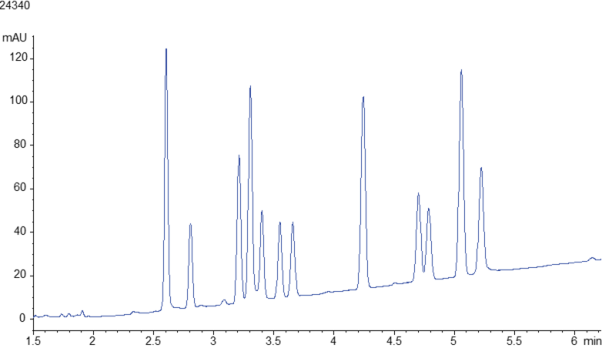Guest author: Jeff Layne
Hello again, and welcome back to my cannabinoid method development article series.  From the last post, we were finally able to find a few different columns that could successfully resolve all 12 of our target analytes within the pressure limitations imposed by the customer, and within a reasonable run time of less than 10 minutes. It is now time to do a little bit of fine-tuning and adjusting to see if there can be more resolution for those critical pairs.
From the last post, we were finally able to find a few different columns that could successfully resolve all 12 of our target analytes within the pressure limitations imposed by the customer, and within a reasonable run time of less than 10 minutes. It is now time to do a little bit of fine-tuning and adjusting to see if there can be more resolution for those critical pairs.
Effect of Temperature
Up until this point, all of the development had been performed with the column in the oven at 35°C. We decided to see if changing the set point will affect the resolution, which resulted in an interesting outcome that can be seen displayed in Figure 1, below. All the data was generated using the Kinetex 2.6 µm Polar C18 column and the running conditions from the previous blog work (MPA = 0.1% TFA in water, MPB = 0.1% TFA in acetonitrile; gradient 75-100% B over 7 min; 1 mL/min), with the only change being the column temperature. Please note that the x-axis scales are adjusted to allow us to focus on the peaks more easily.
Moving from 35°C to 45°C and then to 55°C had a very small effect on resolution of that early critical pair. Visually, it is certainly not apparent, although when the numbers are run, the resolution increased from a value of 1.41 at 35°C to 1.63 at 55°C. As an additional benefit, increasing the temperature from 35°C to 55°C decreased our pressure about 20 Bar and also slightly decreased total run time by about 30 seconds. (We also decreased the starting temperature to ambient and the treatment was consistent with the above results).
Although we did not see a HUGE benefit, there certainly seems to be enough cumulative advantages to operating at ~55°C. We get a little more resolution for our critical pair, allowing us to achieve a final resolution value of 1.63, the pressure is decreased to about 145 Bar, and run time is slightly decreased as well, with the last peak eluting at 5.22 min.
Figure 1. Effect of increasing column temperature on cannabinoids separation.
a. 35°C

b. 45°C

c. 55°C

Final Method
There has now been enough initial screening work done, which provides our customer a good starting point to optimize at their site. The final method, with the peaks identified, is shown in Figure 2.
Column: Kinetex 2.6 µm Polar C18
Dimensions: 150 x 4.6 mm
Part Number: 00F-4759-EO
Mobile Phase: a. Water with 0.1% TFA (**0.1% formic acid, 0.1% phosphoric acid would work as well)
b. Acetonitrile with 0.1% TFA (**0.1% formic acid, 0.1% phosphoric acid would work as well)
**For the cannabinoids – we do not know how the different acidic modifiers might affect the retention behavior of matrix peaks
Gradient: 75 – 100% B over 7 minutes
Flow Rate: 1 mL/min (~150 Bar starting pressure)
Temperature: 55°C
Figure 2. Final method with 12 cannabinoid peaks labeled.
Of course, this is only a “final” method for us – the real challenge will be to run this same method in the presence of various sample matrices. However, that will have to be left up to the experts who are working with cannabinoid samples day in and day out.
I hope you all enjoyed this article series, and maybe even learned something you can apply in your own work. For me, the high point was seeing how my target analytes would not be affected by changing the nature of the acidic additive, making our choice of acid a good way to perhaps fine tune a method for different matrix interferences.
I hope to see you again in my next article!!!
If you have missed out on the last four articles, make sure to start at the beginning! Jeff Tries Cannabis Part 1







Hello Jeff- nice work- what was your injection volume and if you were to use UHPLC – did you try 3mm column ID? Did you optimize the HPLC for dead volume etc. – curious if you try this on a high pressure system and did the method transfer- could use your calculator?